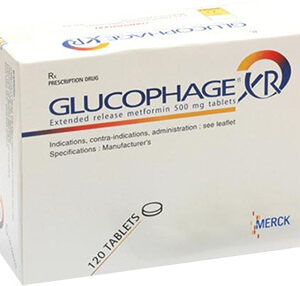Indications and Usage
Forxiga, known generically as dapagliflozin, is a prescription medication belonging to a class of drugs called sodium-glucose cotransporter 2 (SGLT2) inhibitors. It is primarily indicated for the management of blood sugar levels in adults with Type 2 diabetes mellitus in conjunction with diet and exercise. Furthermore, Forxiga is approved for reducing the risk of hospitalization for heart failure in adults with Type 2 diabetes and established cardiovascular disease or multiple cardiovascular risk factors. It can also be used to treat heart failure with reduced ejection fraction to minimize the chances of cardiovascular death and hospitalization for heart failure in adults.
Dosage and Administration
The typical starting dose for Forxiga is 5 mg taken orally once a day in the morning with or without food. Depending upon the patient’s response and tolerability, the dosage may be increased to 10 mg once a day. Renal function should be considered when initiating and monitoring treatment. For managing heart failure or improving mortality outcomes, dosing recommendations may vary. It is vital to follow the healthcare provider’s directions precisely and not to alter the dosage without consultation.
Contraindications
Forxiga should not be used in persons with a history of known hypersensitivity to dapagliflozin or any of the ingredients in Forxiga, as this may result in serious allergic reactions. Additionally, it is not intended for individuals with severe renal impairment, on dialysis, or with end-stage kidney disease. Patients with bladder cancer should also avoid this medication as it may exacerbate their condition.
Warnings and Precautions
Forxiga carries a risk of volume depletion and consequent hypotension, particularly in the elderly and those on diuretics. Kidney function decline, ketoacidosis, and severe urinary tract infections are potential risks and warrant discontinuation of the therapy and immediate medical attention. Forxiga can lead to genital mycotic infections; thus, proper hygiene and monitoring are necessary. Before prescribing Forxiga, assess the patient’s volume status and kidney function, and continually monitor these parameters during treatment.
Adverse Reactions
Common adverse reactions include genital yeast infections, urinary tract infections, and changes in urination frequency. Rare but serious side effects may include diabetic ketoacidosis, kidney injury, and serious allergic reactions. Patients should be counseled on seeking medical help if they experience symptoms indicative of these serious side effects.
Drug Interactions
Concurrently taking Forxiga with diuretics, insulin, or insulin secretagogues can greatly increase the hypoglycemic risk. Careful monitoring of blood glucose is recommended when Forxiga is co-administered with these medications. Other interactions may occur with drugs metabolized by UGT enzymes. Detailed information on potential drug interactions should be reviewed prior to initiating treatment.
Use in Specific Populations
Forxiga should be used with caution in certain populations. In pregnant women, Forxiga should only be used if the potential benefit justifies the potential risk to the fetus. For nursing mothers, a decision should be made to discontinue nursing or discontinue the drug. The safety and efficacy of Forxiga are not established in pediatric patients. In the older population, dosage adjustments may be necessary due to the potential renal function decline.
Overdosage
In the event of an overdose, supportive treatment should be initiated according to the patient’s clinical signs and symptoms. Additionally, prompt measures should be taken to remove the unabsorbed drug. Dialysis may not be effective due to the drug’s high plasma protein binding. Medical attention should be sought immediately if an overdose is suspected.
Clinical Pharmacology
Forxiga inhibits the SGLT2 in the proximal renal tubules, leading to the reduction of reabsorption of glucose from the blood, thereby promoting excretion of glucose via urine. This mechanism results in lowered blood glucose levels in patients with Type 2 diabetes. Additionally, Forxiga exhibits diuretic properties, contributing to its therapeutic effects in heart failure patients.
Nonclinical Toxicology
In animal studies, dapagliflozin was associated with the development of tumors in rodents. The clinical significance of these findings for humans is unclear. Reproductive toxicology studies revealed adverse effects on the fetus at high doses. Forxiga should be utilized during pregnancy only if the benefit outweighs the risk to the fetus.
Clinical Studies
Clinical trials have demonstrated Forxiga’s effectiveness in improving glycemic control in adults with Type 2 diabetes. For heart failure patients, studies indicated a significant reduction in cardiovascular death and heart failure hospitalization when Forxiga was administered. It has also shown to be beneficial in renal outcomes in patients with chronic kidney disease.
How Supplied/Storage and Handling
Forxiga tablets are available in two strengths: 5 mg and 10 mg. They are typically packed in bottles or blister packs. These should be stored at room temperature away from moisture and heat. If a blister pack array is used, it should be kept in the foil package and be protected from light until ready to use.
Patient Counseling Information
Patients should receive counseling regarding the risk of dehydration and the need to maintain adequate fluid intake. They should be informed about the signs and symptoms of ketoacidosis and be advised to seek immediate medical attention if they experience them. It’s also important for patients to be made aware of the risk of genital and urinary tract infections and the appropriate preventative measures.
Medication Guide
As part of providing informed consent, patients should be offered the complete medication guide for Forxiga. It will contain comprehensive details about the usage, risks, and handling of the medication to ensure that patients and caregivers are well-informed about the regimen, side effects, and what to do in cases of adverse events or overdosage.




Reviews
There are no reviews yet.